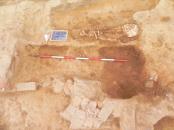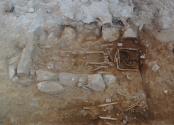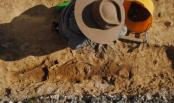CAMPAGNA 2013 |
1° SETTIMANA |
2° SETTIMANA |
3° SETTIMANA |
4° SETTIMANA |
5° SETTIMANA |
6° SETTIMANA |
7° SETTIMANA |
8° SETTIMANA |
25 LUGLIO 2013 
Resoconto della giornata di scavo
Area 1000
Nella giornata di oggi sono state individuate e scavate due buche (US -1225 e US -1228). Considerando che sono concentriche e che il fondo dell'una corrisponde anche al fondo dell'altra, si ipotizza che siano state effettuate nello stesso momento e che lo spazio fra la buca più piccola (US -1225) e la buca più grande (US -1228) fosse riempito in origine da argilla e che servisse come zeppatura per un eventuale palo. Non avendo altri confronti nell'area, per adesso questa rimane solo un'ipotesi. E' stata scavata inoltre un altra buca (US -1230) nella porzione sud del settore B. Questa si presenta come un taglio ellittico riempito da un sedimento argillo limoso caratterizzato dalla presenza di numerose pietre all'interno. La buca taglia una sistemazione di pietre e scisti frammentati che sembra occupare una striscia orientata in senso nord-sud e che dal transetto arriva quasi al limite nord dell'area di scavo. Nei prossimi giorni cercheremo di indagare a fondo questa porzione dell'area che sembra restituire solamente materiale medievale e che dovrebbe garantirci una certa sicurezza cronologica nella datazione.
Today we began by cleaning the entire surface of Section B in Area 1000, then we hosed it down to better see the hypothesized new trench identified in the week past. Afterward we split up into various groups.
Sophie, Steve and Dave worked on one of the hole that had rocky fills. They were searching to identify the edge of the hole which took much of the morning and was not easy. After lunch, they finished digging up the fill and found some iron, lots of rocks and shale, but no human artifacts.
Stephanie and Caitlin continued expanding and clearing out the hole on the eastern side of the diagonal trench, which means excavating a larger hole around the smaller hole filled with black soil. Once we finished removing an inch of dirt we leveled off the surface and then cleaned the surrounding area.
Kailey Anabel began the day with cleaning and then continued working on a small fill that consisted of mostly rocks and a dark sediment. Over the course of the day she removed the rocks and found a layer of charcoal that was kept for future study. Stephanie helped Anabel clean out her hole after she finished her previous work. We dug a few center meters and removed a huge stone. Once that was finished we leveled off the soil and called it a day. By the end of the day, the bottom of the cut had been found, and the hole was cleaned out.
We all ended the day by cleaning the surface of Section B and hosing it down again to take another look at the cluster of cuts we have. We are now hypothesizing that we have a medieval trench, which was only visible due to its fill of rocks rather than any change in soil color.
Area 2000
Terminata l’esposizione e la rimozione di USk 2366 di cui non rimangono preservati gli omeri e gli arti inferiori a causa della presenza dei tagli sepolcrali a Nord (US – 2330), a Sud (US -2294) e a Est (US -2360). L’individuo, un maschio adulto di circa 20/30 anni, è orientato W/E col cranio in normale laterale sinistra enon presenta elementi di corredo. Terminata l’indagine dell’ossario nella porzione centrale del settore: nel riempimento US 2295 è stata rinvenuta una croce bronzea e alcuni chiodi. Al di sotto compare un ulteriore taglio sepolcrale di forma regolare rettangolare, orientato W/E parzialmente riutilizzato per l‘accumulo delle ossa in deposizione secondaria appena documentate. All’interno compare il cranio di un individuo giovanile in connessione con alcune vertebre e numerosi chiodi concentrati lungo i lati corti della fossa. Subito ad Ovest di queste fosse è stato identificato un taglio ellissoidale (US -2370) orientato N/E-S/W: all’interno è stato messo in luce USk 2377 di cui si conservano malamente le coste, le vertebre, la clavicola e la scapola sinistra, parte del cranio. A livello delle vertebre toraciche era presente una medaglia databile al periodo ottocentesco. Nell’angolo Sudoccidentale è stato indagato un taglio circolare intercettato dalle sepolture rinvenute lo scorso anno, il cui riempimento risulta caratterizzato da elementi litici di piccole dimensioni e numerosi grumi di malta.
Area 3000
Nel Settore A si è proceduto con la messa in luce degli individui UUss 3312 e 3313, situati nella porzione Sud-occidentale del settore. In particolare Us 3312, orientato W-E, è deposto supino all’interno della cassa litica US 3310, mentre Us 3313 è sepolto a Nord di essa e presenta lo stesso orientamento. Lo scheletro Us 3312 ha gli arti superiori incrociati sul torace, mentre quelli inferiori sono paralleli e distesi, con le ginocchia e le caviglie convergenti. La rimozione della lastra di ardesia di grandi dimensioni, collocata ad Ovest ha permesso di mettere in luce entrambi gli omeri ed il torace, ben preservato. Us 3313, anch’esso orientato W-E, è in cattivo stato di conservazione e del corpo si conservano l’avambraccio destro, leggermente flesso sul bacino, parte del costato, entrambi i femori, la porzione prossimale della tibia e della fibula destra. Entrambi gli scheletri risultano privi della porzione superiore del corpo, in particolare delle prime vertebre cervicali e del cranio, probabilmente intercettati ed asportati da un taglio trasversale, i cui limiti devono essere ancora chiariti. Nella porzione Nord-orientale del Settore A continua lo scavo dell’individuo medievale Us 3316, orientato W-E, che è stato tagliato all’altezza degli arti inferiori dal corpo di fabbrica costruito nel 1862. Nel Settore B è in corso la messa in evidenza dello scheletro Us 3287, orientato N-S immediatamente a Sud del muro USM 3073, che appare ben preservato.
Cleaned entirety of Area 3000 and photographed with the intentions of recording the two possible lithic coffins on the external of the wall exposed with the new cut and the completed trench’s exposed base.
Sector A 3316 Levelled around skeleton and exposed as much of the right femur as is defined by the cut of area 3000. Cleaned the right femur, radius, ulna, distal humerus and fragmented ribs. Only the right portion of the skeleton is accessible due to the northern limit of the area covering the left side.
3212 continued to uncover skeleton, removed the large piece of slate that covered the thoracic region. To be continued tomorrow.
3314 exposed the whole skeleton to be removed tomorrow. No skull was found.
Sector B skeleton 3287 continued excavation, uncovered part of the axial skeleton including the left ribs and humerus. Believe skeleton is complete, to continue excavation tomorrow.
Southwest of the new extension of the wall, 3090 cleaned and exposed more rocks of a suspected lithic coffin. Found a cut to the east of this primary wall and proceeded to uncover the extent of the cut which ended up cutting north across the wall and across two burials in sector A.
Area 4000
Settore A – Saggio 4800
La rimozione degli strati superficiali relativi all’allargamento del saggio ha permesso di mettere in luce nuove situazioni di taglio legate ad US -4809 (sepoltura orientata est-ovest sita nell’angolo sud orientale dell’approfondimento). Queste nuove situazioni sembrano presentare tutte un andamento nord-sud, e ad oggi, l’indagine è iniziata da US 4817 (riempimento di US -4818) ed US 4804 (riempimento di US -4808). Le concentrazioni di ossa presenti in questi riempimenti e la parallelità ed ortogonalità dei tagli fanno pensare ad un’area cimiteriale anteriore alle strutture medievali (US 4062 ed US 4126).
Settore A – Saggio 4900
L’approfondimento è terminato con l’individuazione di US 4904, un potente strato argilloso omogeneamente distribuito su tutta l’estensione del saggio. La totale assenza di evidenze antropiche negli strati superiori ed in US 4904 stessa, ha sancito la fine dell’indagine di unità catalogate come sterili.
Settore C
Prosegue la rimozione di US 4130 (strato di lastre di ardesia di medie dimensioni) e di US 4136, contesto simile al primo per materiali e concentrazione, ma posto dal lato opposto (quello ovest) della struttura medievale US 4134.
Today in section A, context 4140 was removed to reach the bottom. Once the bottom was reached, we cleaned to prepare for photographs. In the trench we found pottery. The trench is believed to be the cut where a wall once stood, but the stones and rocks were taken to be used in other building projects. In the area 4800 we found the limits of various cuts and cleaned the area in preparation for photographs. In 4817 the limits were defined and we began to remove the fill. In the process we found scattered bones. In section C, we leveled the area around the wall and continued to remove 4130. Our special find was a fish hook, as well as some pottery.













